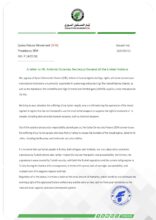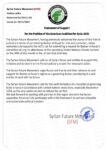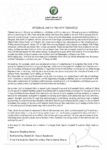Political Sunnism and the Most Effective Solution

Introduction:
The Ottoman Empire ended in 1924, after World War I, leaving the territories it had controlled headless. This power vacuum coincided with the victory of the European Axis and the transition towards what was called the new world order, which ended the dominance of empires in favor of new national or nationalist states. This shift left the map of the former Ottoman territories – the “sick man” – open to non-historical borders, meaning there was no specific geography known as Syria before, but rather a collection of Ottoman provinces and states in most of the region. Consequently, the British and French agreed on what was called the Sykes-Picot Agreement in 1916, to be openly implemented after the fall of the Ottoman Empire. The Sykes-Picot map did not consider anything beyond European interest and thus failed to understand the social nature well, leading to a phase of liberation struggle from these maps by the former Ottoman countries. Turkey succeeded in preventing its division, ending with Atatürk’s current borders, and Syria succeeded in unifying its parts (State of Aleppo, Druze states, etc.), later striving with Egypt towards unity within a national project aimed at unifying the Arab homeland.
The nationalist discourse had the greatest sway in the region, influenced by the idea of the new nation-state, and the Islamic discourse did not succeed in front of the nationalist one, despite stages where both discourses cooperated, as in the case of the Maghreb, and stages in countries where clash was the prominent feature, like Syria.
The Syrian Arab Socialist Ba’ath Party managed to absorb the internal conflict between it and the Ba’ath branch in Iraq, through the latter’s preoccupation with the Iran-Iraq War, and by undermining the Syrian internal opposition, especially the Islamic opposition represented by the Muslim Brotherhood, where the artillery massacre against Alawite officers was a real beginning of exploiting the fight against the Syrian opposition by targeting the Brotherhood, surrounding the communists, and trimming the pluralism within the party after what was called the corrective movement, and Hafez al-Assad’s seizure of power.
Afterwards, Hafez al-Assad managed to succeed through a long journey from political Alawism to controlling the Syrian state through the gateway of nationalism and Ba’ath thought, controlling the state’s threads through the armed forces on one side, and intelligence on the other.
Political Alawism continued to follow a secretive path behind the facade of nationalism and Ba’ath, and its Alawite political influence penetrated until the 2011 revolution, when the Syrian regime revealed its sectarian fangs by intimidating its sect, and shifting towards it at the beginning of the Syrian revolution by tightening its grip, convincing them that the state was theirs, and the regime was them, meaning that losing Assad’s control over it was tantamount to the end of the political Alawite era forever!
The Syrian regime continued its secretive narrative by wearing the guise of nationalism and Ba’ath on one hand, and by wooing senior Sunni sheikhs on the other, until 2015, which is considered the beginning of a significant change to political Alawism through two demolishing tools:
The first tool: Iranian Shia activism, through seizing as much as possible of the military and intelligence forces, thus reaching the Air Force Intelligence and the Fourth Division of the army as well, while weakening the control of other forces with Alawite political nature.
The Second Tool: The emergence of Asma al-Akhras, the wife of Bashar al-Assad, who worked to dismantle the economic structure of political Alawism by initially targeting all Alawite bases, leading to the takeover of all properties of Rami Makhlouf, then uprooting all Alawite roots through the secret office, and establishing the General Secretariat affiliated with Asma al-Assad, which made its backbone from the bourgeois political Sunni forces.
Political Sunnism as a Necessary Balance:
Political Alawism continues to hold its power to this moment, despite persistent efforts to weaken it! Yet, it has not breathed its last! However, the death of major Alawite figures, in addition to Iran’s ongoing acquisition of Alawite power outlets and their replacement with Twelver Shia or Iran-aligned forces through its axis now established in the Syrian arena, and Asma al-Akhras’s failure to conclusively end the intelligence file, which remains under the control of political Alawism.
All this necessitates the presence of a balancing political Sunnism, considered as the suitable solution for Syria’s fragmented state, especially now when the opportunity for the emergence of political Sunnism in the current chaos seems ripe, with four main regions predominantly under Sunni groups, including the SDF, which essentially represents the structure of Sunni Arab tribes.
The necessity for political Sunnism is highlighted through several motives:
First, to end the sense of sectarian oppression felt by the Alawite minority, which has become evident to the entire Syrian population at large. The feeling of injustice and sectarian dominance without the support of a significant political Sunni backbone could be the ashes for future sectarian conflicts that external parties might exploit to ignite future civil wars, even if the current war ends without the formation of political Sunnism.
Second, to dissipate sectarian tensions through political Sunnism, which would take it out of the hands of radical extremist groups like ISIS, which exploit the portrayal of the Syrian regime as an Alawite/Nusayri system to build their extremist narrative. Therefore, the existence of political Sunnism can be seen as a major deconstruction of the narrative of extremist groups, depriving them of a potential popular base.
Third, to achieve real political stability, as the current reality in Syria actively reflects sectarian discourse despite the veil of nationalism and revolution among other terms. The fear of not addressing the legitimate concerns of Sunnis could lead to the re-establishment of a sectarian minority regime that pulls together against others and instills fear of the rest of the Syrian population, especially the Sunni majority. Therefore, the role of political Sunnism in actively participating in power would remove the pretexts for sectarian dominance and genuinely establish national stability.
How Political Sunnism Can Succeed:
This narrative stems from a vision of the current Syrian reality, characterized by several aspects:
The first aspect: The continued presence and dominance of political Alawism and the inability to end it even by the Syrian regime itself, to transition fully to a modern civil state.
The second aspect: The emergence of political Sunnism in areas under the Syrian regime through the leadership of Asma al-Assad, which has proven its ability to quietly and firmly increase its influence within the state at the expense of political Alawism.
The third aspect: The official Syrian opposition represented through its wings:
1- The interim government, the National Coalition, and the Negotiation Authority, on one side, and the National Army on the other.
2- The Syrian Islamic Council as the recognized legislative authority for the opposition as a religious authority.
This represents a case saturated with political Sunnism, making it difficult to break or bypass, even through the establishment of a complete civil state.
The fourth aspect: The situation of Hayat Tahrir al-Sham, which invests in a clear Syrian Sunni project, considering it its primary project over any other national project. This will present us with two non-extremist Sunni narratives politically, and if the moderate one – the opposition – is fought, we will face a dramatic expansion of Hayat Tahrir al-Sham, which has significantly tied its project to the Sunni base in northern Syria.
The Fourth Aspect: The areas under the control of the Syrian Democratic Forces (SDF), which represent a decentralized project on one hand, and on the other hand, a national project whose time has ended or no longer poses an existential threat to the Syrian forces. Generally, the Arab nationalist discourse no longer has a significant presence in the Syrian arena, which places the Kurdish nationalist discourse in a position of non-hostility. Thus, all its concerns can be alleviated through non-confrontational domestic approaches, provided there is a solution with Turkey, the neighboring country that considers the SDF a threat. Regardless of whether the SDF can secure a future political role for itself or fails to do so, its spread depends on the Sunni and Arab tribal structure, which will make political Sunnism a feeder for it from one side, and a strength for the SDF if it can deal with it internally from another side. Therefore, in the face of the failure of the minority alliance in the region, and the political Alawism’s failure to carry this alliance, the SDF, despite the Alawite leadership in Qandil, will face a situation of cooperation with political Sunnism based on the different common grounds between them, especially if it can zero its battles with Turkey, which seems extremely difficult in light of the joint presidency of the autonomous administration as it appears.
These aspects that form the current Syrian reality, which we see as being silently ignored for various reasons, put us in front of the possibility of the unification of political Sunnism despite its differences in the four regions. Therefore, it can be said that there is a possibility of considering “political Sunnism” as a unifying national factor for the following considerations:
- The unifying sectarian “Sunni” factor, which may allow for overcoming the concept of political vengeance, despite the persistence of individual revenge, which will not be significant in the general picture. This makes the demand for “transitional justice,” which is rejected by the de facto powers today, not a barrier to communication between political forces in the four regions and then cooperation, and then merging into one crucible, at least by the majority of these forces.
- The Sunni popular base, especially in the rebellious areas, which would consider the existence of a Sunni political entity an acceptable reference for it. This can explain the Russian mentality when it sent Sunni Chechen forces as ground troops.
- The continued existence of the threat of political Alawism, which necessitates the presence of a balance to end the civil sectarian conflict in Syria, which has largely become sectarian or caused by sectarian reasons.
- The organizational need for the emergence of Sunni forces and the necessity of framing them within a symbolic political reference, rather than leaving them as a scattered condition that is impossible to eliminate as it is to gather without this reference.
Critical Questions:
The previous narrative, based on a cold, unbiased reading of reality, does not advocate sectarian revenge but supports it within a national, coexistence framework, similar to the Lebanese model, and does not sweep its dirt under the carpet. Instead, the narrative aims to air our country’s dirty laundry in the wind and sun to cleanse it from deep-seated corruption.
However, as a Syrian civil political stream that is non-sectarian, we have the right to present our vision regarding the emergence of political Sunnism, to pose some critical questions that we see as aiding in building our national narrative:
- Has political Alawism provided a better life for Syrian Alawites, or has it exploited them for the benefit of a fraction of them? And specifically, does Bashar al-Assad’s policy aim to strengthen political Alawism, or is it merely a small group trying to exploit everything for its benefit? A brief look at the news of Alawites and their sacrifices in Syria for the benefit of political Alawism reveals the enormity of those sacrifices. Do the proponents of the political Sunnism theory want Sunnis to have someone to sacrifice them?
- Regarding the Lebanese experience, is it considered a model to be followed? The electricity file in Lebanon can be cited as an example, where billions were lost to the pockets of Gebran Bassil due to sectarian quotas. It can be argued that considering political Sunnism as the solution is not accurate. Instead, we will be facing a sectarian oligarchy ruling in the name of the group.
3- The existence of “Political Sunnism” might create a missing balance, and indeed, it is desired in today’s Syrian reality. However, it would be an illusory balance, as this situation will not lead us towards a transitional phase to a modern state of citizenship. Relying on Political Sunnism and Political Alawism, and not knowing what will emerge later from Political Druzism and other components that might find an opportunity to emerge, we will face a situation of significant polarization and ongoing sectarian tension. Indeed, this class—if it can be described as such—has the right to rally its base with calculated plots and movements, showing the people’s need for it. This will make the Syrian reality face a situation of polarization by a sectarian group that shares power and benefits from it at the expense of all Syrians, leading to a complete collapse of the concept of the state and the nation.
4- It can be argued that the religious conception of the Sunni people is that they represent the nation; there is no minority concept in the Sunni mindset. Therefore, the existence of Political Sunnism would be a twist in the Sunni mindset itself from the concept of the nation to a secluded minority thought. If we understand the historical context of the Alawites as a marginalized movement that benefited from a historical moment, the Sunni people have not suffered this marginalization. Instead, they have always seen themselves as the social majority. Thus, the existence of Political Sunnism would play with the chemistry of the Sunni mindset!
5- Finally, Political Alawism today is experiencing an existential crisis, from Iran on one side and the expansion of Asma al-Assad on the other. Justifying this existence with the emergence of Political Sunnism means saving Political Alawism.
Conclusion:
We, in the Syrian Future Movement, propose an alternative solution, which is embodied in building a modern civil national state that considers all Syrians within equal legal parameters through a system of rights and duties. This state would hold any sectarian or ethnic political dominance accountable and prevent it from overpowering state institutions. Perhaps this is the most sustainable and comfortable solution for all Syrians. If Political Sunnism could form a power balance in Syria that might end the state of war and conflict, then building a modern state provides a sustainable and more peaceful solution for the Syrian people who generally reject division, despite the tense voices emerging in the current military context.
Moreover, we consider building a modern national state as the most effective solution for immediate reasons:
1- A true, non-illusory national state treats all Syrians equally, cares for all Syrians, and grants them their rights without making them feel aggrieved or inferior.
2- Political Alawism, Political Sunnism, and others hold a hidden thick stick and a heavy burden on the Syrian people. Therefore, a modern state would lift this injustice from all Syrians, regardless of being Sunni, Alawite, Druze, Kurds, etc.
3- A modern state is a state of institutions that connects individuals to moral entities, encouraging them to compete in building it with transparency and objectivity, not binding individuals to groups and personalities. This is perhaps the pinnacle of contemporary human sophistication. A civilized human being, along with a healthy national state, will move beyond the concept of the inspirational leader to an equitable relationship within legal institutions where no human has an advantage over another. This will be overloaded with historical leaders and human references considered sacred in some forms with Political Alawism and Political Sunnism, making the sect as a whole untouchable, which belittles the sect on one hand and makes it hostage to a few individuals on the other.
4- A modern state directs the people’s attention to development, law enforcement, and modern competition, moving them away from minority fears and concerns about protection from a national partner, turning it into an expected enemy. What protects them is the political reference from Alawism and Sunnism, while a true modern national state leans towards building a developed, developmental human being.
Therefore, we recommend in the Research and Studies Department of the Scientific Office for the Syrian Future Movement that the presence of Political Sunnism be considered a realistic solution for the troubled Syrian scene, yet it is an incomplete and unsustainable solution. The most effective solution is building a modern national state.
Jumaa Muhammad Lahib
Political Bureau
Research and Studies Department
Syrian Future Movement
References:
- Syria, during the Ottoman era, comprised three “Vilayets” according to the Ottoman administrative division, before and after the entry of Muhammad Ali Pasha’s army: the Vilayet of Aleppo, Damascus, and Sidon. Each Vilayet included Sanjaks and districts, which were in a state of constant change. See more details in the master’s thesis from the Faculty of Arts, Ain Shams University, Department of History: Abdel Aziz Mohamed Awad, “Public Administration in the Vilayet of Syria 1864 – 1914,” Egypt, Dar al-Maaref, 1389 AH / 1969 AD, p. 66.
- In the introduction of the book “The Road to Sykes-Picot,” it states: “Britain’s share included Palestine, Iraq, and Jordan, alongside Egypt, while current Syria, Lebanon, northern Iraq (Mosul), in addition to the Maghreb, were France’s share. This division of influence areas was not based on geographic logic, historical justification, economic or demographic criteria.” See: “The Road to Sykes-Picot: The First World War from Arab Eyes,” a group of researchers, Doha, Arab Scientific Publishers, 1437 AH / 2016 AD, p. 7.
For more details, see: Amin Mohamed Said and Karim Khalil Thabit, “Biography of Mustafa Kemal Pasha and the History of the Turkish National Movement in Anatolia,” Dar al-Lata’if al-Musawwara, Egypt, 1922, p. 29.
Salah Niyuf, in an article within a publication by the Mesbar Center, mentions four reasons for sidelining Syrian Islamists in the late fifties, which include: not gathering the religious Salafis around them, their conflict with the industrial bourgeoisie and democracy like Khalid al-Azm, not participating with communist and nationalist parties to support workers leading the Brotherhood to later isolate within the middle class only, and Syria’s societal plurality favored unifying terms over religious ones, with the rise of Abdel Nasser and Arab nationalism overwhelmingly. See Salah Niyuf, “The Muslim Brotherhood in Syria: Sectarian Resistance and the Movement’s Violence,” Mesbar Center, no date, p. 6. Munir al-Ghadban states that in August 1979, the Brotherhood officially decided to confront the regime and enter into war with it, following a series of massacres in Syria, especially after the artillery incident which the group denied. He mentioned that this decision was “more emotional than objective as the preparation for such confrontation was not sufficient, but rather motivated by self-defense, not to surrender themselves to the regime.” See Munir al-Ghadban, “Syria in a Century,” p. 574. Hanna Batatu explains Hafez al-Assad’s reliance on the Alawite component in his rule but rejects describing it as sectarian or tribal. In his view, “the power structure shaped by Hafez al-Assad heavily depended on his persona.” See Hanna Batatu, “The Peasantry of Syria, Their Lesser Rural Leaders, and Their Politics,” translated by Abdullah Fadel and Raed al-Naqshbandi, Arab Center for Research, p. 493. Yassin Jamoul and Ahmed Qurbi, “The Iranian Cultural Infiltration in Syria 1,” Syrian Dialogue Center, 2023, in: “The Iranian Cultural Infiltration in Syria (1): Religious Tools” – Syrian Dialogue Center (sydialogue.org)
Officers from the 4th Division training on the use of Iranian drones (jusoor.co)
Rustom Mahmoud believes Russia seeks to reduce Iran’s influence, see: Rustom Mahmoud, “Will Russia Overthrow Iran’s Influence in the Syrian Security Apparatus?” 2019, Independent Arabia (independentarabia.com)
Ibrahim Mustafa, “The End of the Alawite Political Era by Asma al-Akhras,” Syrian Future Movement website, in: “The End of the Alawite Political Era by Asma al-Akhras!” – Syrian Future Movement (sfuturem.org)
“Does Asma al-Assad Expand Her Influence in the Palace Through the Presidential Office?” (jusoor.co)
Azzam al-Qasir, “Survival Strategies of Hay’at Tahrir al-Sham: A Triad of Administration, Militarization, and Discourse,” Harmoon Center, 2023, in: “Survival Strategies of Hay’at Tahrir al-Sham: Administration, Militarization, and Discourse” – Harmoon Center for Contemporary Studies (harmoon.org)
“The Minority Alliance… and Targeting Sunnis!” | Al Jazeera Net (aljazeera.net)
Kadyrov Confirms Sending Chechen Forces to Aleppo as Part of the Military Police Battalion Deployed by Russia for Security and Previously Denied It | Raialyoum (raialyoum.com)
Alawite Losses in Syria and Their Stance on Assad 2-4-2015 (asharqalarabi.org.uk)
Khairallah Khairallah, “Where Did the Billions for Electricity in Lebanon Go,” Al-Arab Newspaper, 2021, in “Where Did the Billions for Electricity in Lebanon Go?” | Khairallah Khairallah | Al-Arab Newspaper (alarab.co.uk).






